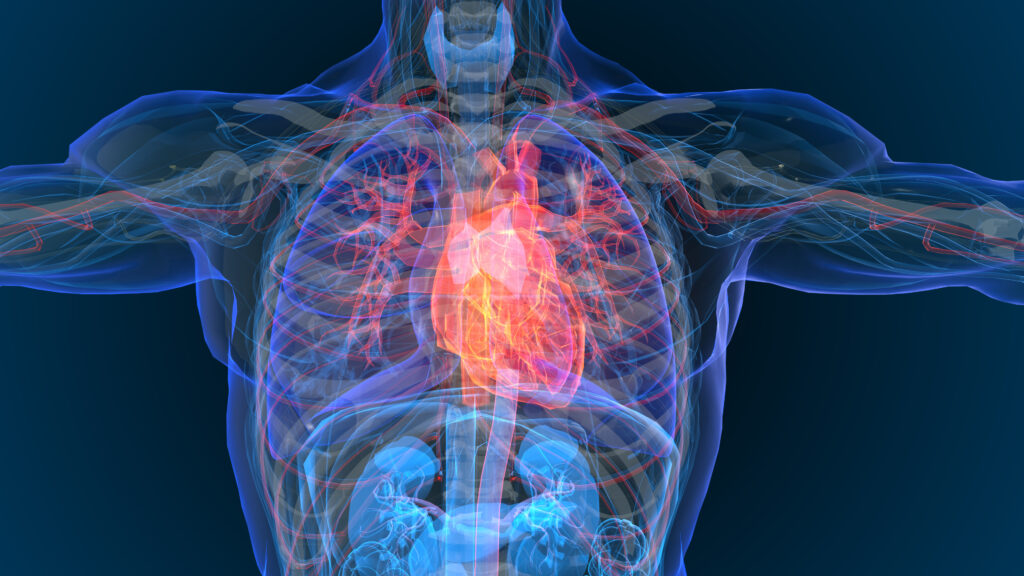Hypothyroidism is usually a progressive disease that impacts the entirety of bodily functions. As the heart is the main target of thyroid hormone activity, hypothyroidism may precipitate or aggravate heart failure, influencing heart rate and blood pressure (BP) while increasing cardiovascular (CV) stiffness and also cardiomegaly.1,2 Overt hypothyroidism (OH) is therefore associated with heightened CV morbidity and mortality.3 Subclinical hypothyroidism (SCH) is defined as a condition characterised by elevated serum thyroid-stimulating hormone (TSH) concentrations (TSH: >4.5 mu/l), while circulating thyroxine (T4) and tri-iodothyronine (T3) levels remain within the population reference range.4 The incidence of SCH varies between 4 and 20 % depending upon the gender (females are more prone), age (older than 65) and population studied.5,6
The consequences of SCH are variable at several levels and may depend on the duration and the degree of elevation of serum TSH. Hence, a number of important questions arise relating to SCH, including whether it raises CV risk and therefore mortality, whether it negatively influences metabolic parameters and whether it should be treated with L-thyroxine.4,7
Besides the classic risk factors for CV disease (CVD), i.e. hypercholesterolaemia and diastolic hypertension, some newer risk factors such as a disrupted coagulability and insulin resistance have recently been evaluated.8 This review aims to update and discuss the available data regarding CV risk in patients with SCH.
Subclinical Hypothyroidism and Lipids
Clinical hypothyroidism has been associated with elevated levels of total cholesterol (TC), low-density lipoprotein cholesterol (LDL-C) and apolipoprotein B (ApoB), all of which contribute substantially to heightened risk of coronary artery disease.9–11 Thyroid hormone controls the generation of cholesterol by regulating the activity of the 3-hydroxy- 3-methylglutaryl-coenzyme A (HMG-CoA) enzyme and its degradation rate by regulating the expression of the SREBP-2 gene, the transcription factor that positively regulates the activity of LDL receptor.12,13 Thus, thyroid hormone action on lipids mainly occurs through an increased expression of LDL receptors at the hepatic and peripheral levels and via an increased activity of the enzymes involved in the metabolism of lipoproteins and reverse cholesterol transport, such as hepatic lipase (HL), lipoprotein lipase (LPL), cholesterol ester transport protein (CETP) and lecithin–cholesterol acyltransferase LCAT.14,15 However, these effects are dependent on the efficiency of thyroid function and/ or the degree of thyroid dysfunction. Changes in HL activity seem to modify cholesterol metabolism in thyroid dysfunction, while the thyroid hormone influence on LPL would appear to be of importance mainly in the disruption of triglyceride (TG) metabolism.15
Several studies have reported increased lipid levels in SCH depending on the degree of hypothyroidism,16,17 though a TSH threshold has not as yet been established.18 In the 5th Tromsø study, a cross-sectional epidemiological, nested case-control study including 5,143 subjects, a significant and positive correlation between serum TSH levels and serum TC and LDL-C levels was registered in both genders.19 Accordingly, patients with newly diagnosed SCH exhibited a significant rise in TGs and LDL-C and low HDLcholesterol compared with the control group after adjustment for age and body mass index (BMI).20 Importantly, women with TSH levels higher than 10 mIU/l exhibited a significant increase in small dense LDL particles, which are associated with a higher atherogenic index,20 On the other hand, an association between free thyroxine (FT4) levels within the normal reference range and lipids, besides the association between SCH and hyperlipidaemia, has been demonstrated,21 while, in addition, low normal FT4 levels were significantly associated with increased insulin resistance, suggesting an increased CV risk in subjects with low normal thyroid function.
In another recent study investigating whether SCH is associated with alterations in hepatic very-low-density lipoprotein (VLDL) metabolism, SCH was found to influence hepatic VLDL-TG but not VLDL-apoB-100 metabolism.22 It is thus evident that SCH increases the hepatic VLDLTG secretion rate compared with the euthyroid state. Moreover, the plasma VLDL-TG concentration was higher in SCH than in euthyroid controls due to greater release of large TG-rich VLDL particles from the liver. Recently it was shown that elevated serum levels of ApoB- 48, a constituent of chylomicrons and chylomicron remnants and a suspected risk factor for atherosclerosis found in both OH and SCH patients, could possibly be reduced by L-T4 replacement.23 It has been hypothesised that these increased serum levels of ApoB-48 in patients with OH and SCH may be related to the disturbed metabolism of chylomicron remnants in patients with hypothyroidism. In the intervention arm of the same study (32 subjects administered T4; 32 subjects placebo), a significant reduction was observed in ApoB levels after T4 medication. Of note, the Tromsø study also revealed that T4 treatment led to lipid reduction in patients with SCH. By contrast, the majority of randomised controlled studies did not reveal any reduction of TC and LDL-C with LT4.7Most notably, no significant effects were seen in patients with baseline TC and LDL-C values that were below 260 mg/dl and 154 mg/dl, respectively, and no difference was found compared with controls.24
Age is an important factor, particularly when treatment is considered. SCH may exert protective effects in the elderly, inducing a lower metabolic rate and reduced adrenergic tone. Moreover, very elderly patients (i.e. above 85 years of age) exhibit some important biological differences from moderately old patients (i.e. 60–70 years), since TC and LDL-C are not considered to be independent CV risk factors in the very old as they are in the middle aged.7,25 Therefore, while by boosting TSH the CV risk is increased in patients with SCH <65 years thereby negatively affecting mortality, a protective mechanism can be observed in patients with SCH who are above 85 years old. Hypothetically, the mortality curve increases in younger SCH patients, i.e. up to the age of 65 years, and thereafter gradually decreases into very old age (see Figure 1).7,26
Recently, in a cross-sectional and controlled study including 49 children with persistent, idiopathic, long-standing (3.2±0.4 years), mild SCH (TSH: 4.5–10 mU/l), waist-to-height-ratio (WHtR) (p<0.0001), atherogenic index (p=0.001), TGs/high-density (HDL)-cholesterol ratio (p=0.01) and homocysteine levels (p=0.002) were significantly higher and HDLcholesterol significantly lower (p=0.003) in SCH subjects compared with 49 controls.27 Following adjustment for BMI, these variables remained significantly associated with the TSH levels or with SCH duration. indicating that even mild, long-lasting, untreated SCH may be associated with various pro-atherogenic abnormalities.
Subclinical Hypothyroidism and Arterial Hypertension
Though as yet a controversial matter, an association has been hypothesised between SCH and BP. Thus, in a cross-sectional study conducted among 6,992 inhabitants from six districts of Jiangsu province in China, SCH was not associated with BP and SCH did not independently predict increased relative risk (RR).28 In the Busselton study, neither mean systolic BP (SBP) and diastolic BP (DBP) nor the prevalence of hypertension differed significantly between SCH patients and controls.29 By contrast, as shown in the Hunt study examining 9,709 women and 4,644 men without previous thyroid disease, high normal TSH levels were associated with modestly higher future levels of BP, this implying that TSH levels may co-vary with BP among people with apparently normal thyroid function.30
In a meta-analysis on the relationship between SCH and SBP, SCH was associated with an elevated SBP and it was therefore hypothesised that it might serve as a potential risk factor for high SBP.31 Undoubtedly, welldesigned and large sample-sized prospective studies are needed to confirm the association between SCH and BP to determine whether treatment with T4 may be beneficial for BP.
Hypothyroidism has been associated with arterial stiffness and left ventricular diastolic dysfunction.32,33 In a cross-sectional study investigating the relationship between thyroid hormone level and cardio-ankle vascular index (CAVI) and left ventricular diastolic function in 83 patients with untreated SCH, log N-terminal prohormone of brain natriuretic peptide (NT-proBNP), CAVI and C-reactive protein (CRP) were found higher in SCH.34 Thus, high logNT-proBNP might be associated with a raised CAVI in patients with SCH, this state possibly constituting a risk factor for CV events related to arterial stiffening and left ventricular diastolic dysfunction.34
Additionally, SCH may represent a risk factor for coronary artery calcification (CAC), especially in subjects with intermediate and high CV risk scores.35 Thus, CAC score (CACS) was found higher in SCH patients compared with controls (Cntr versus SCH; p=0.045). In a multivariate analysis, the risk for CACS >100 was independently associated with male gender, age >55 years and the presence of SCH.
Hypercoagulation and Insulin Resistance
More recently, CRP, homocysteine, increased arterial stiffness, endothelial dysfunction and altered coagulation parameters have been implicated in SCH.36 There have also been reports of abnormalities in glucose metabolism and in haemostatic parameters, the latter being mainly indicated by the increased activity of factor VII37 and plasminogen activator inhibitor-1, suggesting that a hypofibrinolytic and hypercoagulable state may play a significant role in the development of atherosclerosis in patients with SCH.38
A recent report in patients with a post-non-ST elevation acute coronary syndrome found a higher thrombus burden in the subclinically hypothyroid ones compared with euthyroid individuals, as evidenced by the area of the thrombus: mean 23,608 versus 16,661 mm2/mm (p=0.02).39 However, this association was not detectable when the analysis was limited to patients with serum TSH within the reference range, since neither serum FT4 nor FT3 had any significant association with the thrombus area.39 Serum TSH levels, particularly in the SCH range, were associated with a higher thrombus burden despite optimal recommended secondary prevention therapy, this possibly accounting for the higher CV risk seen in SCH patients.
In a cross-sectional study including 753 subjects and investigating the role of intrahepatic fat accumulation in the association of SCH with insulin resistance, the prevalence of fatty liver (FL) was not different among euthyroid and SCH patients (31.8 versus 27.8 %; p=0.371).40 However, the FL plus SCH subjects were heavier and exhibited more metabolic abnormalities compared with those with SCH and no FL. According to the authors, patients with SCH and FL have increased odds for insulin resistance, the metabolic syndrome and also CAC.
The association between SCH and weight changes in the elderly was the objective of a recent study examining a total of 427 SCH patients >65 years old over a period of 6 years.41 Patients with SCH showed no fluctuations in weight at a single time point compared with euthyroid controls, nor were differences in lean mass or fat percent noted. It is of interest that a TSH level of 1 mU/l higher within the SCH or euthyroid range, as well as a 1 ng/dl higher FT4 level, were associated with a 0.5 kg higher baseline weight or lower baseline weight and 0.3 kg/year greater weight loss in women, respectively. Though the association between SCH and weight is not at present well defined, these results indicate that SCH does not exert a significant impact on weight in the elderly. Nevertheless, there are still some limitations that should be considered, as normal values of TSH are not as yet clearly defined for every population: the upper limit is ageand race-related and it might also be dependent on occult autoimmune thyroiditis or inactivating polymorphisms of TSH receptor.4
Subclinical Hypothyroidism and Mortality
SCH has been associated with increased risk of CHD, and several studies and meta-analyses have investigated the association of SCH with CV risk and mortality.42,43 The aforementioned Busselton study, which was conducted in Australia to examine the prevalence of CHD in patients with and without SCH, found a higher statistical significant in both the crosssectional and longitudinal analysis (age- and sex-adjusted hazard ratio [HR] 1.7; 95 % confidence interval [CI] 1.2–2.4; p<0.01) in SCH patients compared with euthyroid controls.44 Importantly, the increased risk of CHD events remained significant after adjustment for standard CV risk factors. A high risk of coronary heart disease (CHD) events and mortality was reported in dependency on the degree of TSH, with lower risk of all-cause mortality in SCH patients having a TSH between 5–10 mU/l, and also in subjects younger than 65 years.45 According to another metaanalysis, SCH is associated with a significant risk of CHD at baseline (RR with 95 % CI 1.533 [1.312–1.791]; p<0.05) and at follow-up (RR with 95 % CI 1.188 [1.024–1.379]; p<0.05).46 The noted discrepancies among the various studies have been attributed to different study designs, degree of SCH and gender and age of the study populations.47
More recently, in a Taiwanese 10-year follow-up study including 11,574 participants without a history of thyroid disease in which SCH was defined as a serum TS level of 5.0–19.96 mU/l with normal TT4 concentrations, 680 out of 3,669 deaths were due to CVD.48 Compared with euthyroid subjects after adjustment for several confounders, the relative ratio of deaths from all causes and CVD among subjects with SCH was increased, indicating that Taiwanese with SCH have an increased risk for all-cause mortality and CVD death.
In a large prospective cohort study, 212,456 middle-aged euthyroid men and women, without a history of thyroid disease at baseline, were followed from 2002 to 2009.49 Serum concentrations of FT4 and FT3 within the normal range, were inversely associated with the risk of all-cause mortality and also cancer mortality, particularly liver cancer mortality, while TSH was not associated with mortality endpoints.49 By contrast, an analysis of data of 55,287 participants in 11 prospective cohort studies in the US, Europe, Australia, Brazil and Japan50 revealed an increased risk of CHD events and CHD mortality with increasing TSH concentrations above 10 mU/l.50 The SCH was however defined as a TSH level from 4.5 mU/l to 19.9 mIU/l with normal serum T4 levels. Notably, the results were similar after adjustment for traditional CV risk factors and the risks were not significantly modified by age, sex or pre-existing CVD. The risk of all-cause mortality, major adverse CV events (MACEs) and cause-specific events in subjects with overt and subclinical dysfunction was investigated in a retrospective cohort study in Denmark.51 While the risk of MACEs was elevated in both overt and subclinical hyperthyroidism driven by heart failure, a reduction of all-cause mortality was registered in SCH with TSH of 5–10 mIU/l (Incidence rate ratio [IRR] 0.92, 95 % CI 0.86–0.98).
It has recently been reported that CHD risk associated with SCH is not modified by thyroid peroxidase antibody (TPOAb) status, suggesting that biomarkers of thyroid autoimmunity do not add independent prognostic information concerning CHD outcomes.52
Treatment Options and Conclusions
Despite the fact that LT4 treatment in SCH has resulted in an improvement of various CV risk factors and quality of life,53 there is no evidence that treatment is able to reverse CV lesions by decreasing CV risk, especially in those patients with TSH <10 mU/l. While numerous clinicians may routinely disregard SCH in the context of TSH levels <10, sufficient evidence exists indicating that these individuals could be exposed to enhanced CV risk, this moreover possibly aggravated by insulin resistance as well as augmented by the co-existence of additional risk factors.54,55 Furthermore, recent findings showing that raised serum TSH has a different impact on the lipid profile in morbidly obese compared with non-obese patients indicate that obese patients might not be truly hypothyroid.56 Therefore, measurement of TC could be helpful when a decision should be made whether a morbidly obese patient with a raised serum TSH should be treated with levothyroxine treatment or not.
Therefore, until randomised, controlled, prospective and adequately powered trials are carried out, it is advisable to prescribe LT4 therapy on an individualised basis,57 taking into account the risk both of progressive thyroid disease and of CV events. Symptomatic patients, those with CV risk factors, pregnant women, patients with Hashimoto thyroiditis and subjects with ovulatory dysfunction and infertility should as a general rule be treated as their symptoms associated with SCH can potentially be reversed.
Mild SCH (<10 mu/l) should be scrutinised and carefully followed up so as to preclude progression of disease and promptly initiate treatment. Moderate SCH (>10 mu/l) has a negative impact on various CV risk factors and should be treated in patients <65 years. More elderly patients need to be regularly evaluated, while those older than 85 years should probably be followed up, though treatment is largely uncalled for.













